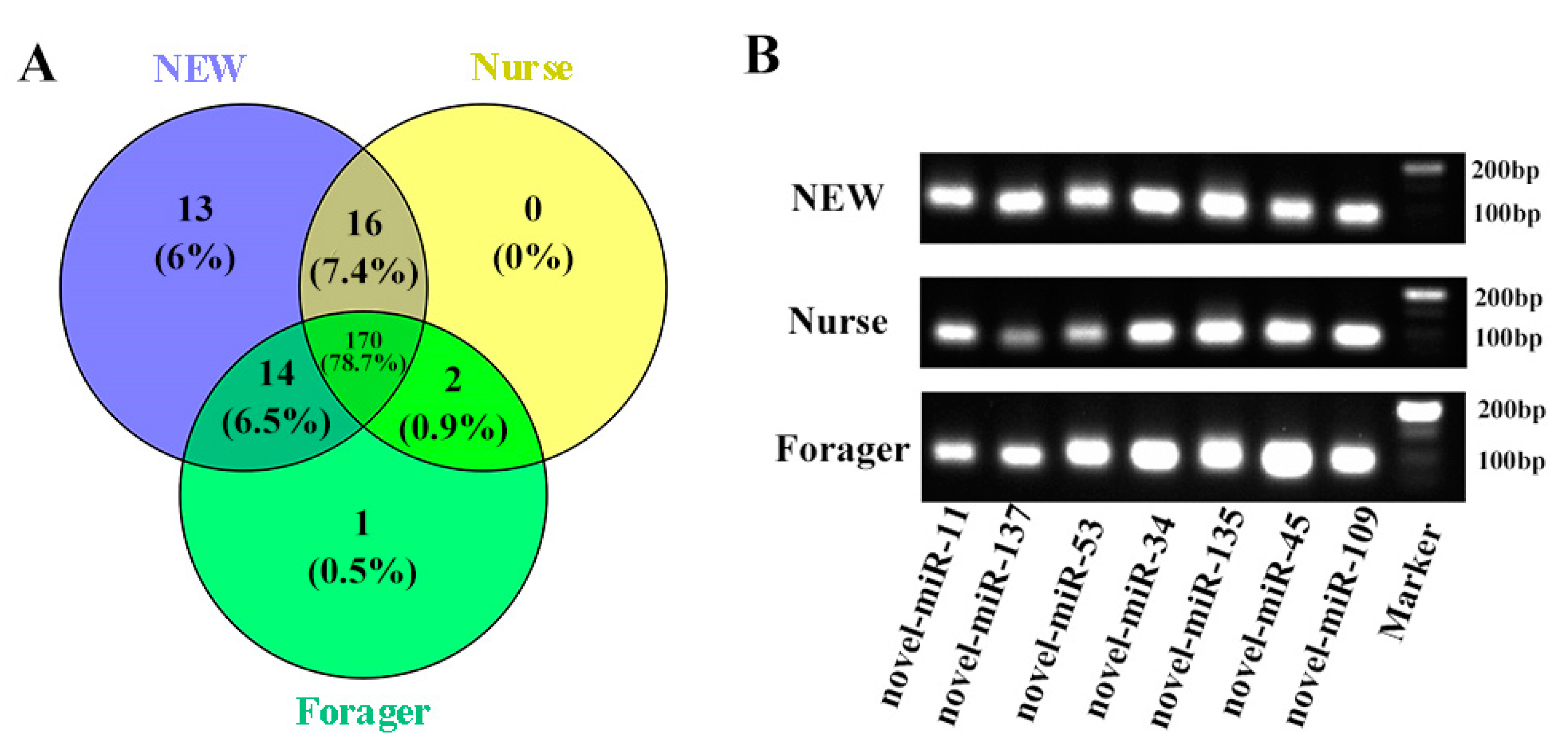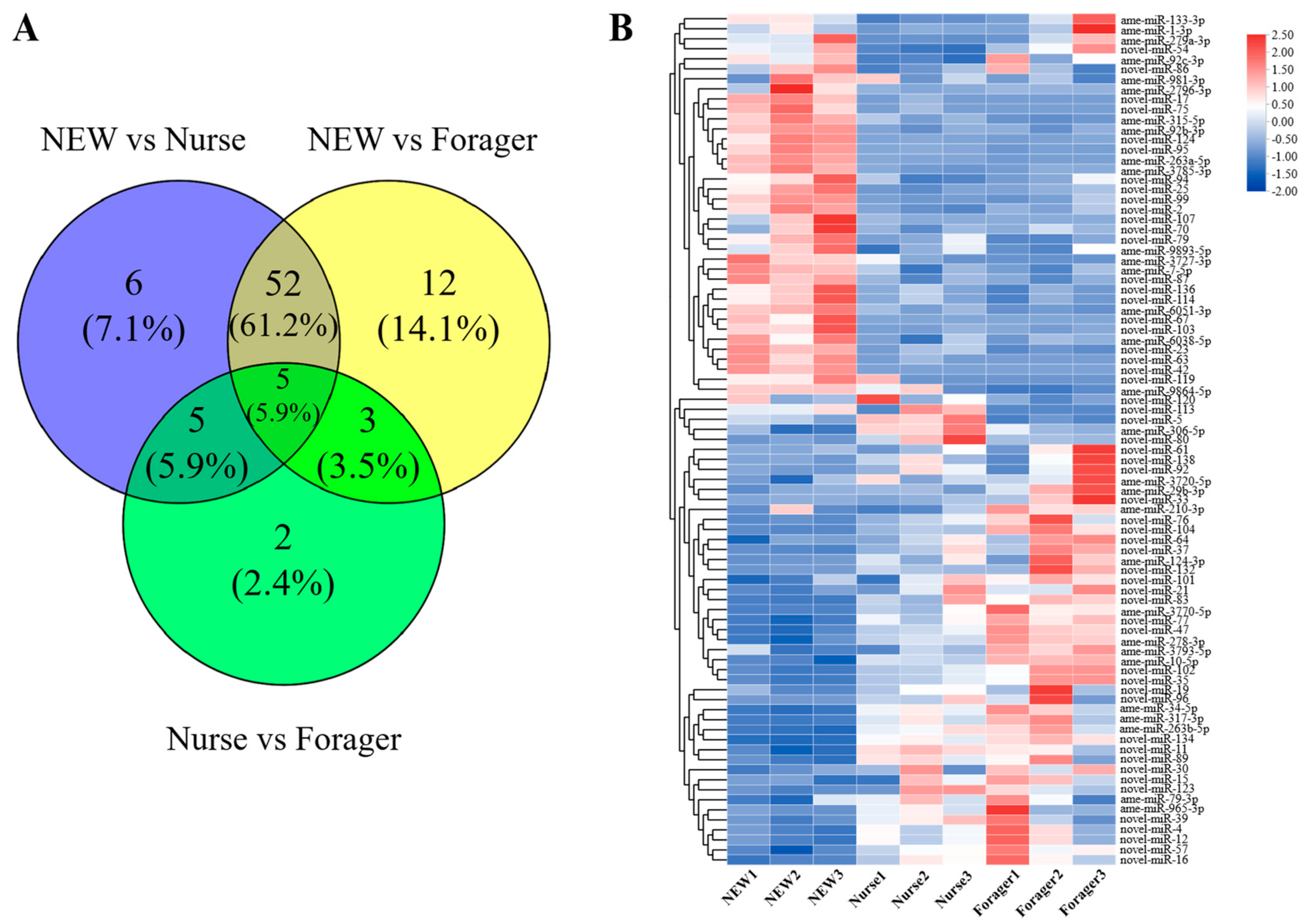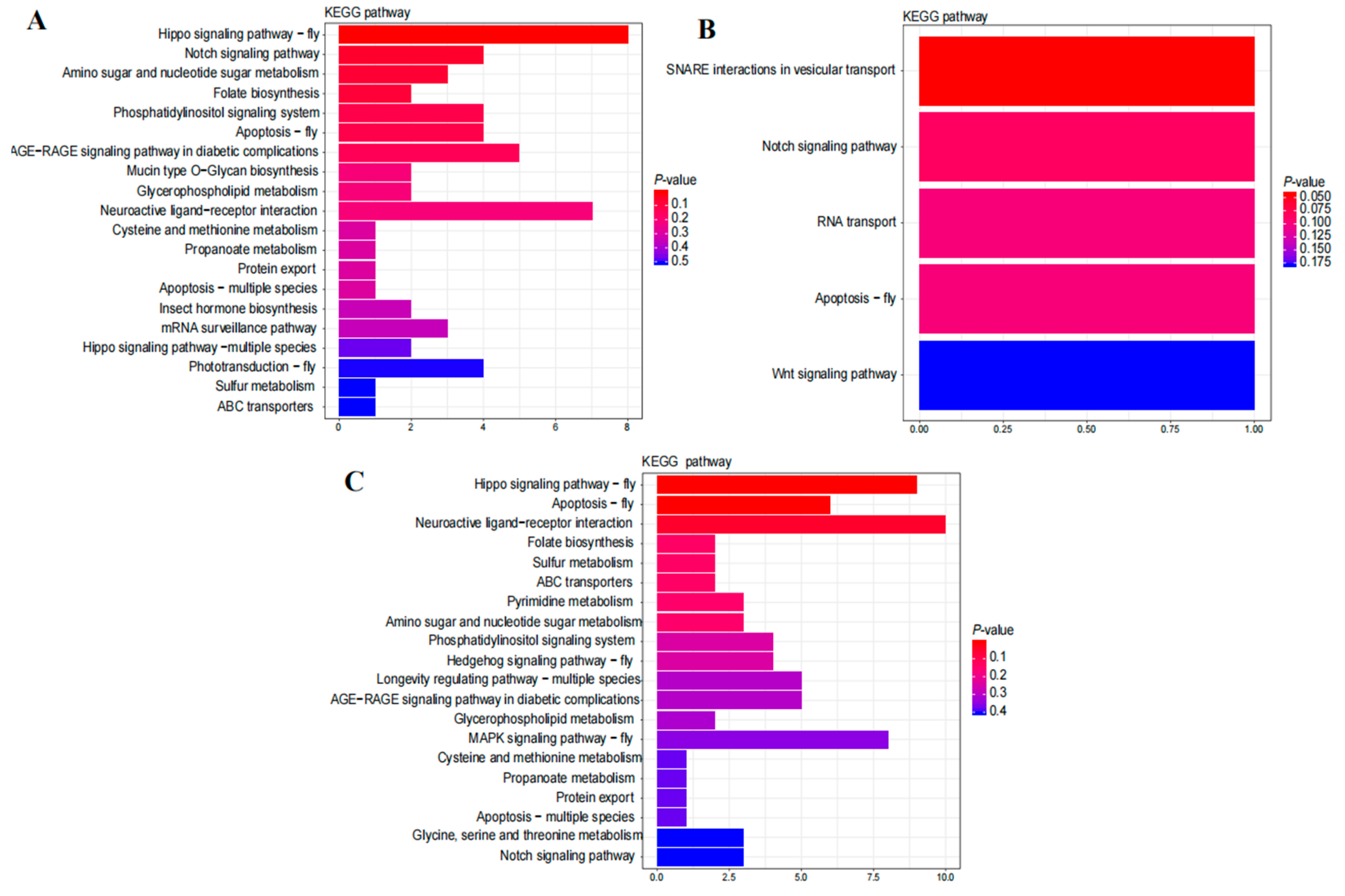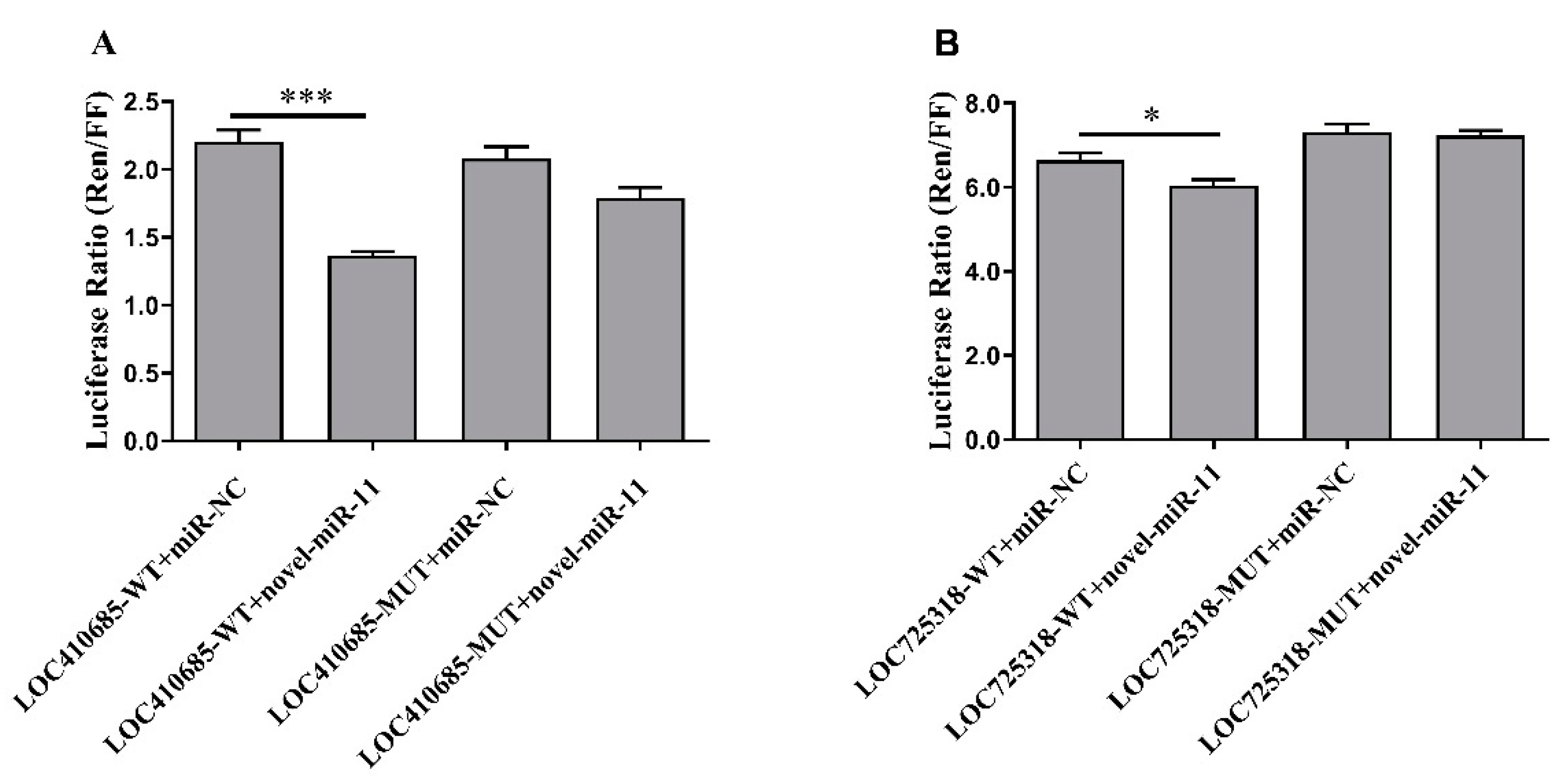Expression Profile of microRNAs during Development of the Hypopharyngeal Gland in Honey Bee, Apis mellifera
Abstract
1. Introduction
2. Results
2.1. Statistics of Sequencing Results
2.2. Known miRNAs and Novel miRNAs
2.3. Differentially Expressed miRNAs
2.4. Target Genes of DEmiRNAs
2.5. miR-11 Targets LOC410685 and LOC725318
3. Discussion
4. Materials and Methods
4.1. Insects
4.2. Construction of Small RNA Libraries and High Throughput Sequencing
4.3. Identification of Known miRNAs and Novel miRNAs
4.4. Screening of Differentially Expressed miRNAs
4.5. Prediction of miRNA Targets
4.6. Verification of Novel miRNAs and DEmiRNAs
4.7. Dual-Luciferase-Reporter Assay
Supplementary Materials
Author Contributions
Funding
Institutional Review Board Statement
Informed Consent Statement
Data Availability Statement
Acknowledgments
Conflicts of Interest
References
- Wu, J.; Yan, J.C.; Xiao, B. Honeybee Biology; Chinese Agricultural Press: Beijing, China, 2012; Volume 8–90. [Google Scholar]
- Kubo, T.; Sasaki, M.; Nakamura, J.; Sasagawa, H.; Ohashi, K.; Takeuchi, H.; Natori, S. Change in the expression of hypopharyngeal-gland proteins of the worker honeybees (Apis mellifera L.) with age and/or role. J. Biochem. 1996, 119, 291–295. [Google Scholar] [CrossRef]
- Ohashi, K.; Natori, S.; Kubo, T. Expression of amylase and glucose oxidase in the hypopharyngeal gland with an age-dependent role change of the worker honeybee (Apis mellifera L.). Eur. J. Biochem. 1999, 265, 127–133. [Google Scholar] [CrossRef] [PubMed]
- Ohashi, K.; Natori, S.; Kubo, T. Change in the mode of gene expression of the hypopharyngeal gland cells with an age-dependent role change of the worker honeybee Apis mellifera L. Eur. J. Biochem. 1997, 249, 797–802. [Google Scholar] [CrossRef]
- Ueno, T.; Takeuchi, H.; Kawasaki, K.; Kubo, T. Changes in the gene expression profiles of the hypopharyngeal gland of worker honeybees in association with worker behavior and hormonal factors. PLoS ONE 2015, 10, e0130206. [Google Scholar] [CrossRef] [PubMed]
- Corby-Harris, V.; Snyder, L.; Meador, C.; Watkins-DeJong, E.; Obernesser, B.T.; Brown, N.; Carroll, M.J. Diet and pheromones interact to shape honey bee (Apis mellifera) worker physiology. J. Insect Physiol. 2022, 143, 104442. [Google Scholar] [CrossRef]
- Mohammedi, A.; Crauser, D.; Paris, A.; Le Conte, Y. Effect of a brood pheromone on honeybee hypopharyngeal glands. C. R. L’academie Sci. Serie III Sci. Vie 1996, 319, 769–772. [Google Scholar]
- Ohashi, K.; Sasaki, M.; Sasagawa, H.; Nakamura, J.; Natori, S.; Kubo, T. Functional flexibility of the honey bee hypopharyngeal gland in a dequeened colony. Zool. Sci. 2000, 17, 1089–1094. [Google Scholar] [CrossRef] [PubMed]
- Liu, Z.; Ji, T.; Yin, L.; Shen, J.; Shen, F.; Chen, G. Transcriptome sequencing analysis reveals the regulation of the hypopharyngeal glands in the honey bee, Apis mellifera carnica Pollmann. PLoS ONE 2013, 8, e81001. [Google Scholar] [CrossRef] [PubMed][Green Version]
- Liu, H.; Wang, Z.-L.; Tian, L.-Q.; Qin, Q.-H.; Wu, X.-B.; Yan, W.-Y.; Zeng, Z.-J. Transcriptome differences in the hypopharyngeal gland between Western Honeybees (Apis mellifera) and Eastern Honeybees (Apis cerana). BMC Genom. 2014, 15, 744. [Google Scholar] [CrossRef]
- Li, J.; Feng, M.; Begna, D.; Fang, Y.; Zheng, A. Proteome comparison of hypopharyngeal gland development between Italian and royal jelly producing worker honeybees (Apis mellifera L.). J. Proteome Res. 2010, 9, 6578–6594. [Google Scholar] [CrossRef] [PubMed]
- Wang, K.; Liu, Z.-g.; Lin, Z.-g.; Yin, L.; Gao, F.-c.; Chen, G.-h.; Ji, T. Epigenetic modifications may regulate the activation of the hypopharyngeal gland of honeybees (Apis mellifera) during winter. Front. Genet. 2020, 11, 46. [Google Scholar] [CrossRef] [PubMed]
- Bartel, D.P. MicroRNAs: Genomics, biogenesis, mechanism, and function. Cell 2004, 116, 281–297. [Google Scholar] [CrossRef]
- Peng, W.; Deng, W.; Zhang, J.; Pei, G.; Rong, Q.; Zhu, S. Long noncoding RNA ANCR suppresses bone formation of periodontal ligament stem cells via sponging miRNA-758. Biochem. Biophys. Res. Commun. 2018, 503, 815–821. [Google Scholar] [CrossRef] [PubMed]
- Liu, J.; Wang, X.; Yang, X.; Liu, Y.; Shi, Y.; Ren, J.; Guleng, B. miRNA423-5p regulates cell proliferation and invasion by targeting trefoil factor 1 in gastric cancer cells. Cancer Lett. 2014, 347, 98–104. [Google Scholar] [CrossRef] [PubMed]
- Schoolmeesters, A.; Eklund, T.; Leake, D.; Vermeulen, A.; Smith, Q.; Force Aldred, S.; Fedorov, Y. Functional profiling reveals critical role for miRNA in differentiation of human mesenchymal stem cells. PLoS ONE 2009, 4, e5605. [Google Scholar] [CrossRef]
- Hammond, S.M. MicroRNAs as oncogenes. Curr. Opin. Genet. Dev. 2006, 16, 4–9. [Google Scholar] [CrossRef]
- Sur, S.; Steele, R.; Shi, X.; Ray, R.B. miRNA-29b inhibits prostate tumor growth and induces apoptosis by increasing bim expression. Cells 2019, 8, 1455. [Google Scholar] [CrossRef]
- Cristino, A.S.; Tanaka, E.D.; Rubio, M.; Piulachs, M.-D.; Belles, X. Deep sequencing of organ-and stage-specific microRNAs in the evolutionarily basal insect Blattella germanica (L.) (Dictyoptera, Blattellidae). PLoS ONE 2011, 6, e19350. [Google Scholar] [CrossRef]
- Wu, C.; Blondin, P.; Vigneault, C.; Labrecque, R.; Sirard, M.-A. Sperm miRNAs—Potential mediators of bull age and early embryo development. BMC Genom. 2020, 21, 798. [Google Scholar] [CrossRef]
- Cristino, A.S.; Barchuk, A.R.; Freitas, F.C.; Narayanan, R.K.; Biergans, S.D.; Zhao, Z.; Simoes, Z.L.; Reinhard, J.; Claudianos, C. Neuroligin-associated microRNA-932 targets actin and regulates memory in the honeybee. Nat. Commun. 2014, 5, 5529. [Google Scholar] [CrossRef]
- Geng, W.; Tang, H.; Luo, S.; Lv, Y.; Liang, D.; Kang, X.; Hong, W. Exosomes from miRNA-126-modified ADSCs promotes functional recovery after stroke in rats by improving neurogenesis and suppressing microglia activation. Am. J. Transl. Res. 2019, 11, 780. [Google Scholar] [PubMed]
- Ma, F.; Xu, S.; Liu, X.; Zhang, Q.; Xu, X.; Liu, M.; Hua, M.; Li, N.; Yao, H.; Cao, X. The microRNA miR-29 controls innate and adaptive immune responses to intracellular bacterial infection by targeting interferon-γ. Nat. Immunol. 2011, 12, 861–869. [Google Scholar] [CrossRef] [PubMed]
- Naqvi, A.R.; Shango, J.; Seal, A.; Shukla, D.; Nares, S. Viral miRNAs alter host cell miRNA profiles and modulate innate immune responses. Front. Immunol. 2018, 9, 433. [Google Scholar] [CrossRef] [PubMed]
- Leung, A.K.; Sharp, P.A. MicroRNA functions in stress responses. Mol. Cell 2010, 40, 205–215. [Google Scholar] [CrossRef]
- Luoreng, Z.-M.; Wang, X.-P.; Mei, C.-G.; Zan, L.-S. Expression profiling of peripheral blood miRNA using RNAseq technology in dairy cows with Escherichia coli-induced mastitis. Sci. Rep. 2018, 8, 12693. [Google Scholar] [CrossRef]
- Weaver, D.B.; Anzola, J.M.; Evans, J.D.; Reid, J.G.; Reese, J.T.; Childs, K.L.; Zdobnov, E.M.; Samanta, M.P.; Miller, J.; Elsik, C.G. Computational and transcriptional evidence for microRNAs in the honey bee genome. Genome Biol. 2007, 8, R97. [Google Scholar] [CrossRef]
- Chen, X.; Yu, X.; Cai, Y.; Zheng, H.; Yu, D.; Liu, G.; Zhou, Q.; Hu, S.; Hu, F. Next-generation small RNA sequencing for microRNAs profiling in the honey bee Apis mellifera. Insect Mol. Biol. 2010, 19, 799–805. [Google Scholar] [CrossRef]
- Collins, D.H.; Mohorianu, I.; Beckers, M.; Moulton, V.; Dalmay, T.; Bourke, A.F. MicroRNAs associated with caste determination and differentiation in a primitively eusocial insect. Sci. Rep. 2017, 7, 45674. [Google Scholar] [CrossRef]
- Greenberg, J.; Xia, J.; Zhou, X.; Thatcher, S.; Gu, X.; Ament, S.; Newman, T.; Green, P.; Zhang, W.; Robinson, G. Behavioral plasticity in honey bees is associated with differences in brain microRNA transcriptome. Genes Brain Behav. 2012, 11, 660–670. [Google Scholar] [CrossRef]
- Li, L.; Liu, F.; Li, W.; Li, Z.; Pan, J.; Yan, L.; Zhang, S.; Huang, Z.Y.; Su, S. Differences in microRNAs and their expressions between foraging and dancing honey bees, Apis mellifera L. J. Insect Physiol. 2012, 58, 1438–1443. [Google Scholar] [CrossRef]
- Qin, Q.H.; Wang, Z.L.; Tian, L.Q.; Gan, H.Y.; Zhang, S.W.; Zeng, Z.J. The integrative analysis of microRNA and mRNA expression in Apis mellifera following maze-based visual pattern learning. Insect Sci. 2014, 21, 619–636. [Google Scholar] [CrossRef] [PubMed]
- Hilgers, V.; Bushati, N.; Cohen, S.M. Drosophila microRNAs 263a/b confer robustness during development by protecting nascent sense organs from apoptosis. PLoS Biol. 2010, 8, e1000396. [Google Scholar] [CrossRef] [PubMed]
- Li, J.; Cai, Y.; Ye, L.; Wang, S.; Che, J.; You, Z.; Yu, J.; Zhong, B. MicroRNA expression profiling of the fifth-instar posterior silk gland of Bombyx mori. BMC Genom. 2014, 15, 1–11. [Google Scholar] [CrossRef] [PubMed]
- Yang, H.; Li, M.; Hu, X.; Xin, T.; Zhang, S.; Zhao, G.; Xuan, T.; Li, M. MicroRNA-dependent roles of Drosha and Pasha in the Drosophila larval ovary morphogenesis. Dev. Biol. 2016, 416, 312–323. [Google Scholar] [CrossRef]
- Zhang, Q.; Dou, W.; Song, Z.-H.; Jin, T.-J.; Yuan, G.-R.; De Schutter, K.; Smagghe, G.; Wang, J.-J. Identification and profiling of Bactrocera dorsalis microRNAs and their potential roles in regulating the developmental transitions of egg hatching, molting, pupation and adult eclosion. Insect Biochem. Mol. Biol. 2020, 127, 103475. [Google Scholar] [CrossRef]
- Freitas, F.C.; Pires, C.V.; Claudianos, C.; Cristino, A.S.; Simões, Z.L. MicroRNA-34 directly targets pair-rule genes and cytoskeleton component in the honey bee. Sci. Rep. 2017, 7, 40884. [Google Scholar] [CrossRef]
- Vieira, J.; Freitas, F.; Cristino, A.S.; Moda, L.; Martins, J.; Bitondi, M.; Simões, Z.; Barchuk, A. miRNA-34 and miRNA-210 target hexamerin genes enhancing their differential expression during early brain development of honeybee (Apis mellifera) castes. Insect Mol. Biol. 2021, 30, 594–604. [Google Scholar] [CrossRef]
- Chen, L.; Qin, F.; Deng, X.; Avruch, J.; Zhou, D. Hippo pathway in intestinal homeostasis and tumorigenesis. Protein Cell 2012, 3, 305–310. [Google Scholar] [CrossRef]
- Halder, G.; Johnson, R.L. Hippo signaling: Growth control and beyond. Development 2011, 138, 9–22. [Google Scholar] [CrossRef]
- Tepass, U.; Theres, C.; Knust, E. crumbs encodes an EGF-like protein expressed on apical membranes of Drosophila epithelial cells and required for organization of epithelia. Cell 1990, 61, 787–799. [Google Scholar] [CrossRef]
- Richardson, E.C.; Pichaud, F. Crumbs is required to achieve proper organ size control during Drosophila head development. Development 2010, 137, 641–650. [Google Scholar] [CrossRef] [PubMed]
- Feitosa, N.M.; Zhang, J.; Carney, T.J.; Metzger, M.; Korzh, V.; Bloch, W.; Hammerschmidt, M. Hemicentin 2 and Fibulin 1 are required for epidermal–dermal junction formation and fin mesenchymal cell migration during zebrafish development. Dev. Biol. 2012, 369, 235–248. [Google Scholar] [CrossRef] [PubMed]
- Ren, J.; Li, X.; Dong, H.; Suo, L.; Zhang, J.; Zhang, L.; Zhang, J. miR-210-3p regulates the proliferation and apoptosis of non-small cell lung cancer cells by targeting SIN3A. Exp. Ther. Med. 2019, 18, 2565–2573. [Google Scholar] [CrossRef] [PubMed]
- Garzon, R.; Heaphy, C.; Havelange, V.; Fabbri, M.; Volinia, S.; Tsao, T.; Zanesi, N.; Kornblau, S.M.; Marcucci, G.; Calin, G.A. MicroRNA 29b functions in acute myeloid leukemia. Blood 2009, 114, 5331–5341. [Google Scholar] [CrossRef]
- Puppo, F.; Thomé, V.; Lhoumeau, A.C.; Cibois, M.; Gangar, A.; Lembo, F.; Belotti, E.; Marchetto, S.; Lécine, P.; Prébet, T. Protein tyrosine kinase 7 has a conserved role in Wnt/β-catenin canonical signalling. EMBO Rep. 2011, 12, 43–49. [Google Scholar] [CrossRef]
- Lu, X.; Borchers, A.; Jolicoeur, C.; Rayburn, H.; Tessier-Lavigne, M. PTK7/CCK-4 is a novel regulator of planar cell polarity in vertebrates. Nature 2004, 430, 93–98. [Google Scholar] [CrossRef]
- Shnitsar, I.; Borchers, A. PTK7 recruits dsh to regulate neural crest migration. Development 2008, 135, 4015. [Google Scholar] [CrossRef]
- Mello, T.; Aleixo, A.; Pinheiro, D.; Nunes, F.; Cristino, A.; Bitondi, M.; Barchuk, A.; Simões, Z. Hormonal control and target genes of ftz-f1 expression in the honeybee Apis mellifera: A positive loop linking juvenile hormone, ftz-f1, and vitellogenin. Insect Mol. Biol. 2019, 28, 145–159. [Google Scholar] [CrossRef]
- Langmead, B.; Trapnell, C.; Pop, M.; Salzberg, S.L. Ultrafast and memory-efficient alignment of short DNA sequences to the human genome. Genome Biol. 2009, 10, 1–10. [Google Scholar] [CrossRef]
- Friedländer, M.R.; Mackowiak, S.D.; Li, N.; Chen, W.; Rajewsky, N. miRDeep2 accurately identifies known and hundreds of novel microRNA genes in seven animal clades. Nucleic Acids Res. 2012, 40, 37–52. [Google Scholar] [CrossRef]
- Li, B.; Ruotti, V.; Stewart, R.M.; Thomson, J.A.; Dewey, C.N. RNA-Seq gene expression estimation with read mapping uncertainty. Bioinformatics 2010, 26, 493–500. [Google Scholar] [CrossRef] [PubMed]
- Love, M.I.; Huber, W.; Anders, S. Moderated estimation of fold change and dispersion for RNA-seq data with DESeq2. Genome Biol. 2014, 15, 550. [Google Scholar] [CrossRef] [PubMed]
- Betel, D.; Wilson, M.; Gabow, A.; Marks, D.S.; Sander, C. The microRNA. org resource: Targets and expression. Nucleic Acids Res. 2008, 36 (Suppl. S1), D149–D153. [Google Scholar] [CrossRef] [PubMed]
- Lewis, B.P.; Shih, I.-h.; Jones-Rhoades, M.W.; Bartel, D.P.; Burge, C.B. Prediction of mammalian microRNA targets. Cell 2003, 115, 787–798. [Google Scholar] [CrossRef]
- Busk, P.K. A tool for design of primers for microRNA-specific quantitative RT-qPCR. BMC Bioinform. 2014, 15, 29. [Google Scholar] [CrossRef] [PubMed]





| Sample | Raw Reads | Clean Reads | Q30 (%) | Unannotated Reads | Mapped Unannotated Reads |
|---|---|---|---|---|---|
| NEW1 | 14,566,809 | 10,560,784 | 98.14 | 4,495,092 | 2,299,248 (51.15%) |
| NEW2 | 50,870,653 | 44,999,092 | 96.96 | 19,548,174 | 10,379,450 (53.10%) |
| NEW3 | 25,761,918 | 19,506,666 | 97.15 | 8,216,128 | 4,194,771(51.06%) |
| nurse1 | 17,193,017 | 11,653,112 | 97.56 | 5,655,312 | 2,329,792 (41.20%) |
| nurse2 | 24,858,856 | 20,396,246 | 97.34 | 8,819,202 | 4,017,379 (45.55%) |
| nurse3 | 13,970,243 | 11,579,964 | 98.18 | 4,423,128 | 2,260,265 (51.10%) |
| forager1 | 12,815,475 | 10,594,494 | 98.05 | 4,722,875 | 1,884,181 (39,89%) |
| forager2 | 15,885,906 | 12,159,719 | 98.17 | 5,701,605 | 2,527,884 (44.34%) |
| forager3 | 14,744,683 | 12,205,485 | 98.27 | 4,285,110 | 2,341,378 (54.64%) |
| Sample | Known miRNAs | Novel miRNAs | Total |
|---|---|---|---|
| NEW | 79 | 134 | 213 |
| Nurse | 68 | 120 | 188 |
| Forager | 69 | 118 | 187 |
| Total | 81 | 135 | 216 |
Publisher’s Note: MDPI stays neutral with regard to jurisdictional claims in published maps and institutional affiliations. |
© 2022 by the authors. Licensee MDPI, Basel, Switzerland. This article is an open access article distributed under the terms and conditions of the Creative Commons Attribution (CC BY) license (https://creativecommons.org/licenses/by/4.0/).
Share and Cite
Qin, K.; Cheng, F.; Pan, L.; Wang, Z. Expression Profile of microRNAs during Development of the Hypopharyngeal Gland in Honey Bee, Apis mellifera. Int. J. Mol. Sci. 2022, 23, 12970. https://doi.org/10.3390/ijms232112970
Qin K, Cheng F, Pan L, Wang Z. Expression Profile of microRNAs during Development of the Hypopharyngeal Gland in Honey Bee, Apis mellifera. International Journal of Molecular Sciences. 2022; 23(21):12970. https://doi.org/10.3390/ijms232112970
Chicago/Turabian StyleQin, Kaixin, Fuping Cheng, Luxia Pan, and Zilong Wang. 2022. "Expression Profile of microRNAs during Development of the Hypopharyngeal Gland in Honey Bee, Apis mellifera" International Journal of Molecular Sciences 23, no. 21: 12970. https://doi.org/10.3390/ijms232112970
APA StyleQin, K., Cheng, F., Pan, L., & Wang, Z. (2022). Expression Profile of microRNAs during Development of the Hypopharyngeal Gland in Honey Bee, Apis mellifera. International Journal of Molecular Sciences, 23(21), 12970. https://doi.org/10.3390/ijms232112970






